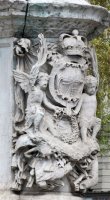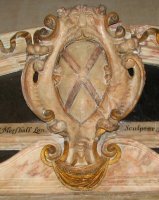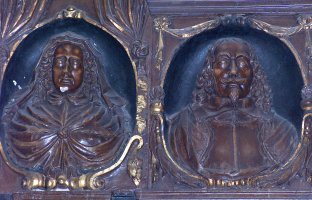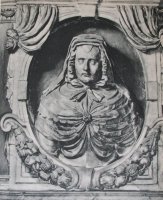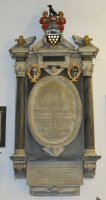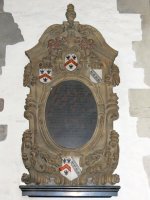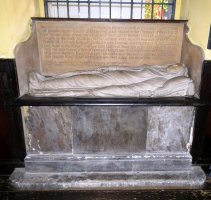Joshua Marshall (1628-1678)
The sculptor Joshua Marshall was the first son of the sculptor Edward Marshall, and the only one to survive him, and followed his father's professional path, acting as first Wardon and then Master in the Mason's Company, and effectively inheriting his role as Master Mason to the Crown when his father retired the post, and taking over his father's workshop and premises after he died.
Architectural carving by Joshua Marshall, and cartouche.
His mason's work, included working for Christopher Wren on several of the City Churches after the Great Fire, including the surviving ones of St Peter Cornhill, St Mary at Hill, St Clement Danes (just the tower), and St Bride's, and in his role as Master Mason to the Crown undertook work in the Royal Palaces. From that role we have our two surviving significant pieces of outdoor sculpture by Joshua Marshall: two large pediments at Greenwich Palace (not the grandest one though), and the base of Hubert le Sueur's statue of King Charles I in Trafalgar Square. The Greenwich pediments (see picture above, click to enlarge), based on pairs of reclining figures, are well preserved within their pedimental niches, good of their types, but not, I would say, particularly distinctive as being by the hand of Marshall. The base of the Charles I statue, above left, is a bit more battered by time, but maybe more characterful: at each end of the base is a mass of carving of the Royal arms flanked by a pair of cherubs, with a busy background of hanging drapery, weapons and armour. Aside from these two pieces, I think only the odd surviving bit of smaller decorative work (e.g. above centre) represents his architectural sculpture.
Joshua Marshall - portrait sculpture.
There survive some small number of church monuments which are signed or documented to being of Joshua Marshall's workmanship, however there are many more unsigned works which are very similar and are therefore ascribed to his hand. Like his father, Joshua Marshall's oeuvre includes some pieces which are Classical Baroque, with pilasters to the sides, pediments above which tend to some complexity and variety, and carved supporting brackets below, with the majority of the carving a the top of the monument. We also have some more entirely sculptural pieces, as in the panel to Jane Clitheroe, pictured below right, in Ruislip, West London. There are portrait busts: among several pieces in St Margaret Westminster, we may note the bust to Mary Brocas, pictured here (above right). These are generally darkened, with a rather medieval look to them, serious, highly modelled features, sharply defined brow and cheekbone and deep set eyes. And then there are the occasional full figures, of which Lady Frances Kniveton in St Giles in the Fields is an accessible London example: she is clad in a winding sheet, rather thin material to allow the sculptor to show the curves of her body, one arm holding to the drapery, and her head raised on a tasselled pillow, all resting on a plain bench-like altar tomb (see picture further down).
Panel types: Bridgeman and Clitherow.
Joshua Marshall did not long survive his father, who died in 1675, and the Marshall monument in St Dunstan in the West is to both father and son: two of the monuments ascribed to Joshua Marshall also are within the Church, one of the pillared type, and one with a portrait bust – both pictured on the St Dunstan in the West page.
Lady Kniveton.

